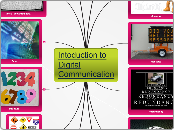Intoduction to Digital Communication

Reciever

Infomation

Message

Redundancy

Pattern

Syntagm

Sender

Noise (unwanted data)
Visual Noise
Audio Noise
Semantic Noise
Psycological Noise

Data
Signal Percieved in a medium
Percieved difference
Percieved among signals
Binary signal

Structure

Rules

